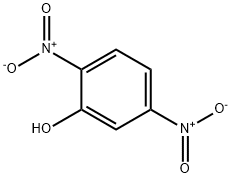2,5-DINITROPHENOL

|
- ₹0
- Product name: 2,5-DINITROPHENOL
- CAS: 329-71-5
- MF: C6H4N2O5
- MW: 184.11
- EINECS:206-348-1
- MDL Number:MFCD00007108
- Synonyms:2,5-Dinitrofenol;2,5-dinitro-pheno ;2,5-Dnp;2,5-Dinitrophenol (wetted with ca. 20% Water) (unit weight on dry weight basis);2,5-Dinitrophenol ( betta );gamma-dinitro-pheno ;Phenol, 2,5-dinitro-;Phenol, gamma-dinitro-
| Manufacturer | Product number | Product description | Packaging | Price | Updated | Buy |
|---|
Properties
Melting point :103-106 °C(lit.)
Boiling point :318.03°C (rough estimate)
Density :1.7195 (rough estimate)
refractive index :1.4738 (estimate)
solubility :Solubility Sparingly soluble in water; soluble in ethanol, ether
pka :5.21, 5.1, 5.0(at 25℃)
form :Solid
color :Yellowish needles
PH Range :4(colourless)-5.8(yellow)
Merck :14,3281
BRN :1913411
Stability :Light Sensitive
Major Application :Liquid crystal films, electrophotographic materials, adhesives, inks, lubricants, preservation of cut flowers, food storage, materials for evaluating dental cariesactivity
CAS DataBase Reference :329-71-5(CAS DataBase Reference)
EPA Substance Registry System :2,5-Dinitrophenol (329-71-5)
Boiling point :318.03°C (rough estimate)
Density :1.7195 (rough estimate)
refractive index :1.4738 (estimate)
solubility :Solubility Sparingly soluble in water; soluble in ethanol, ether
pka :5.21, 5.1, 5.0(at 25℃)
form :Solid
color :Yellowish needles
PH Range :4(colourless)-5.8(yellow)
Merck :14,3281
BRN :1913411
Stability :Light Sensitive
Major Application :Liquid crystal films, electrophotographic materials, adhesives, inks, lubricants, preservation of cut flowers, food storage, materials for evaluating dental cariesactivity
CAS DataBase Reference :329-71-5(CAS DataBase Reference)
EPA Substance Registry System :2,5-Dinitrophenol (329-71-5)
Safety Information
| Symbol(GHS): |
   
|
|||||||||||||||||||||||||||||||||||||||||||||||||
|---|---|---|---|---|---|---|---|---|---|---|---|---|---|---|---|---|---|---|---|---|---|---|---|---|---|---|---|---|---|---|---|---|---|---|---|---|---|---|---|---|---|---|---|---|---|---|---|---|---|---|
| Signal word: | Danger | |||||||||||||||||||||||||||||||||||||||||||||||||
| Hazard statements: |
|
|||||||||||||||||||||||||||||||||||||||||||||||||
| Precautionary statements: |
|
Description
2,5-Dinitrophenol (wetted with ca. 20% Water) (unit weight on dry weight basis) is a useful reagent for the preparation of yttrium nitrophenolate aminebis(benzotriazolylphenolate) complexes.Related product price
- 2-Methyl-4,6-dinitrophenol
₹6516.65-47796.6 - 2,4-Dinitrophenol
₹1948.5-7209.45 - 4097-49-8
₹2300-50405






